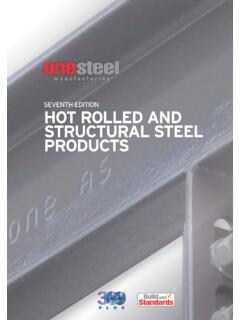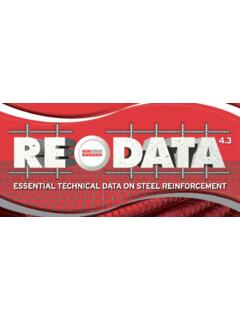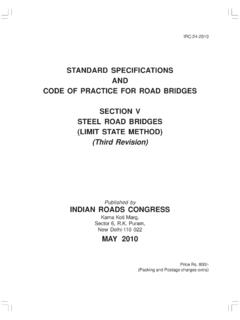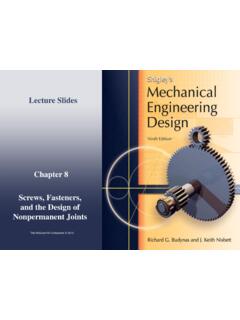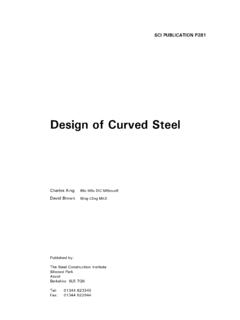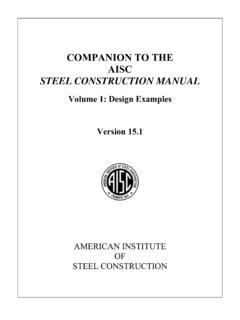Transcription of DESIGN CAPACITY TABLES - Liberty
1 DESIGN CAPACITY TABLES FOR STRUCTURAL STEEL HOLLOW SECTIONSD esign CAPACITY TABLES for Structural Steel Hollow SectionsGeneral InformationSection PageForeword (iii)Preface (iv)Notation & Abbreviations (vi)Standards and Other References (ix)ContentsSection PagePart 1 Introduction 1-1 part 2 Materials 2-1 part 3 Section Properties 3-1 part 4 Methods of Structural Analysis 4-1 part 5 members Subject to Bending 5-1 part 6 members Subject to Axial compression 6-1 part 7 members Subject to Axial Tension 7-1 part 8 members Subject to Combined Actions 8-1 part 9 Connections 9-1 See page (ii) for the appropriate use of this Tube Mills 21 123 666 679. PO Box 246 Sunnybank, Queensland 4109 Australia Telephone +61 7 3909 6600 Facsimile +61 7 3909 6660 E-mail Internet Tube Mills 21 123 666 679. PO Box 246 Sunnybank, Queensland 4109 Australia Telephone +61 7 3909 6600 Facsimile +61 7 3909 6660 E-mail Internet CAPACITY TABLES for Structural Steel Hollow SectionsAUGUST 2013 part 0 GeneralPART 1 InformationPART 2 MaterialsPART 3 Section PropertiesPART 4 Methods ofStructural AnalysisPART 5 members Subjectto BendingPART 6 members Subjectto Axial CompressionPART 7 members Subjectto Axial TensionPART 8 members Subjectto Combined ActionsPART 9 ConnectionsAustralian Tube Mills 21 123 666 679.
2 PO Box 246 Sunnybank, Queensland 4109 Australia Telephone +61 7 3909 6600 Facsimile +61 7 3909 6660 E-mail Internet (i)Australian Tube Mills 21 123 666 679. PO Box 246 Sunnybank, Queensland 4109 Australia Telephone +61 7 3909 6600 Facsimile +61 7 3909 6660 E-mail Internet CAPACITY TABLES for Structural Steel Hollow Sections(ii)Australian Tube Mills 21 123 666 679 DESIGN CAPACITY TABLES FOR STRUCTURAL STEEL HOLLOW SECTIONSP ublished by: AUSTRALIAN TUBE MILLSE nquiries should be addressed to the publisher: Postal address: Box 246, Sunnybank, Queensland 4109, Australia E-mail address: Internet: 2013 Australian Tube Mills First issue June 2003 Second issue December 2010 Third issue August 2013 Disclaimer - Whilst every care has been taken in the preparation of this information, Australian Tube Mills, and its agents accept no liability for the accuracy of the information supplied.
3 The company expressly disclaims all and any liability to any person whether a purchaser of any product, or otherwise in respect of anything done or omitted to be done and the consequences of anything done or omitted to be done, by any such person in reliance, whether in whole or in part upon the whole or any part of this - This publication should not be used without the services of a competent professional with suitable knowledge in the relevant field, and under no circumstances should this publication be relied upon to replace any or all of the knowledge and expertise of such a CAPACITY TABLES for Structural Steel Hollow SectionsRelevance of information contained in this PublicationMaterial Standards and product qualities:USERS OF THIS PUBLICATION SHOULD NOTE THAT THE DESIGN CAPACITIES, CALCULATIONS, TABULATIONS AND OTHER INFORMATION PRESENT IN THIS PUBLICATION ARE SPECIFICALLY RELEVANT TO STRUCTURAL STEEL HOLLOW SECTIONS SUPPLIED BY Australian Tube , the information contained in this publication cannot be readily used for hollow sections supplied from other manufacturers as those sections may vary significantly in grade, thickness, size, material Standard compliance (including chemical composition, mechanical properties, tolerances) and quality when compared to structural steel hollow sections supplied from Australian Tube Mills (ATM).
4 In many instances, the higher strengths and qualities provided by ATM structural steel hollow sections to obtain efficient and economical designs from structural mass reductions cannot be readily provided by hollow sections from other steelwork/engineering Standards:The maximum DESIGN loads and DESIGN capacities listed in this publication are based on the limit states DESIGN method of AS 4100 and the factored limit states DESIGN loads and combinations considered within AS/NZS 1170. Hence, much of the information contained herein will only be of use to persons familiar with the limit states DESIGN method and the use of: AS 4100 Steel structures AS/NZS 1170 Structural DESIGN actionsProduct availability & other information:As the section, grade and finish of all products are subject to continuous improvement, reference should be made to the ATM PRODUCT AVAILABILITY GUIDE (PAG) for information on the availability of listed sections and associated finishes.
5 The current version of the PAG can be found on the ATM website Software:Much of the information contained in this publication can also be readily obtained from the computer software package TubeComp which can be run in Windows 95, 98, 2000 and XP. TubeComp is a simple calculator for structural steel hollow sections designed to AS 4100:1998. TubeComp can provide exact calculated values for specific effective lengths and screens are dynamically updated when data is entered. Most of the information in this publication can be obtained by just four clicks of a mouse in TubeComp which can be freely obtained by contacting ATM or visiting 2013 ForewordAustralian Tube Mills is one of the world s premier producers of welded steel tube and pipe for structural, mechanical and low pressure reticulation applications. For many years, Australian Tube Mills has been at the industry forefront with numerous innovations delivering significant value to a wide range of key industries.
6 With manufacturing facilities strategically located in Australia (Brisbane, Newcastle, Melbourne and Perth), Australian Tube Mills is effectively placed to supply high quality tubular steel products to markets in Australia, New Zealand, South Pacific and South-East Tube Mills innovative approach to the development of tubular products has been noted by various industries for many years. This has included the introduction and ongoing push of higher strength RHS and Pipe products which reduce weight and cut costs for end-users. Strength enhancements began with Grade C350L0 ( TruBlu ), then Grade C450L0 ( GreensTuf ) and DuraGal and now C450 PLUS (previously DualGrade C350L0/C450L0) products. Australian Tube Mills were the first to develop and promote these grades into Australian Standards and its market areas and now offer the largest range of C450 PLUS sections not only in Australia but across the of tubular shapes has also been an important strategy for Australian Tube Mills.
7 Specific shapes (some of which carry patents and trademarks) were developed for defined industries and include the SiloTube, UniRail, StockRail and Architectural sections. Limited rollings of other forms of hollow sections can be supplied on a special order from material improvements, Australian Tube Mills plants also produce different types of coating systems for tubular products. Revolutionary primer-paint systems were developed with industry participation to protect hollow sections from rust during warehouse storage, transportation and fabrication as well as offer a smooth clean work surface during and after fabrication. Australian Tube Mills now supplies the largest range of welded tubular steel products in Australia which vary in shape, grade and finish. Compared to other steel products, the worldwide consumption of welded tubular steel products is significantly increasing. The main reasons for this outcome is due to the aesthetics, engineering efficiencies, cost-effectiveness, increased specifier/end-user awareness and the high value-adding inherent with tubular products.
8 This has now firmly positioned Australian Tube Mills as the preferred tubular supplier within many products, people and service sets Australian Tube Mills apart from its competitors. AcknowledgementsAustralian Tube Mills gratefully acknowledges the assistance provided by the Australian Steel Institute (ASI) previously the Australian Institute of Steel Construction (AISC) for permitting the use of their DESIGN CAPACITY TABLES text and format in the development of various parts of this , Australian Tube Mills wishes to acknowledge the detailed contributions from the following: Russell Watkins of Australian Tube Mills for writing, generating and checking the text, TABLES and graphs used in this publication; OneSteel s marketing services team for artwork and coordination; and Nick van der Kreek at Australian Tube Mills for checking and updating various aspects of this CAPACITY TABLES for Structural Steel Hollow SectionsAUGUST 2013 part 0 GeneralPART 1 InformationPART 2 MaterialsPART 3 Section PropertiesPART 4 Methods ofStructural AnalysisPART 5 members Subjectto BendingPART 6 members Subjectto Axial CompressionPART 7 members Subjectto Axial TensionPART 8 members Subjectto Combined ActionsPART 9 ConnectionsAustralian Tube Mills 21 123 666 679.
9 PO Box 246 Sunnybank, Queensland 4109 Australia Telephone +61 7 3909 6600 Facsimile +61 7 3909 6660 E-mail Internet (iii)Australian Tube Mills 21 123 666 679. PO Box 246 Sunnybank, Queensland 4109 Australia Telephone +61 7 3909 6600 Facsimile +61 7 3909 6660 E-mail Internet CAPACITY TABLES for Structural Steel Hollow Sections(iv)PrefaceThe DESIGN CAPACITY TABLES for Structural Steel (DCT) suite of publications from the Australian Steel Institute (ASI) previously the Australian Institute of Steel Construction (AISC) has been commonly used by DESIGN engineers for at least a decade. The actual origin of these publications goes back to 1969 when the Safe Load TABLES (SLT) was published by AISC (at the time) for the then permissible stress based steel structures Standards AS CA-1 and subsequently AS 1250. The SLT was published in six editions (the last edition being in 1987) with both hot-rolled open sections ( UB, UC, PFC, etc) and structural steel hollow sections (CHS, RHS and SHS) included in its release of AS 4100 Steel Structures in 1990 to supersede AS 1250 saw a change in DESIGN philosophy from permissible stress to limit states DESIGN principles.
10 Such a change prompted the revision of the SLT to manifest itself as the DCT. The first edition of the DCT had an overall format which was similar to the sixth edition of the SLT and included both open and hollow sections. However, due to the growing popularity, increasing range and innovation of hollow section construction, the DCT was effectively split in 1992 with the release of the DESIGN CAPACITY TABLES for Structural Steel Hollow Sections (DCTHS) which only considered tubular members . Thereafter, a second edition of the DCTHS was released in 1999 entitled DESIGN CAPACITY TABLES for Structural Steel Volume 2: Hollow Sections (DCT-v2:HS).While somewhat of a challenge, the aim of the DCT-v2:HS (and preceding DCTHS/DCT) was to provide current information on hollow sections available from various manufacturers. However, at the time of publication, the consolidated product range listing from each of the manufacturers was disjointed and not reflective of available sections.






